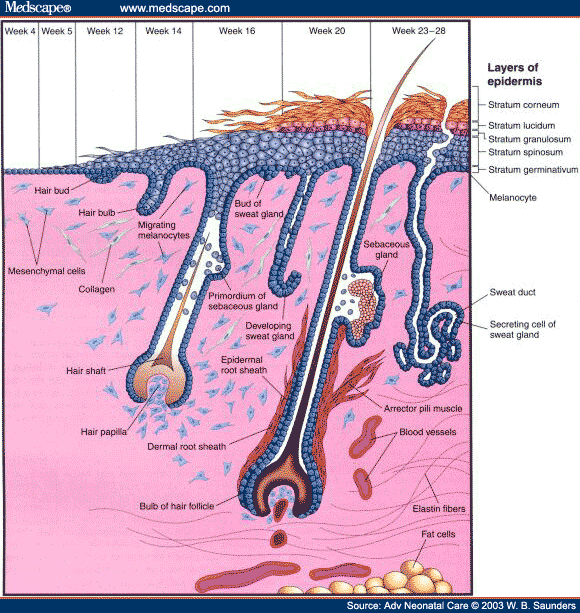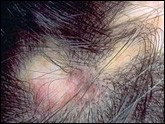Dermatology - Hair Disorders
From Iusmicm
Contents |
[edit] Hair Disorders
[edit] Anatomy
- Need to know: shaft, vitreous membrane, epithelial cells, inner / outer shaft, cuticle, bulb, dermal papilla (vascularized), matrix (actively dividing keratinocytes), divisions (infundibulum: down to sabaceous gland, isthmus: sabaceous to erectus pili muscle, inferior segment: erector pili to bulb)
- Only the isthmus is the permanent portion of the hair follicle (because it contains the bulge with stem cells).
- In the anagen stage, the follicle sits down in the dermal region.
[edit] Hair growth
- There are three phases of hair growth: anagen (growing), catagen (involuting), telogen (resting).
- There are about 100K follicles on our head
- Blonds have 20% more
- Redheads have 20% less
- Anagen phase:
- Hair is actively growting
- 85-95% of scalp hair follicles are in the anagen phase
- Most follicles grow (are in the anagen phase) for 2-6 years
**During anagen, scalp hairs grow at a arate 0.35 mm / (day)?
- Duration in which hair is able to spend in anagen determines how long one can grow their hair
- Anagen duration is what makes arm hair shorter than scalp hair
- Catagen phase
- During catagen, hair involutes or fall out.
- Very few scalp hairs are in the catagen phase in a healthy state.
- It is normal to lose up to 100 hairs each day
- Major stressor do end up causing excessive loss of hair
- Telogen phase
- A follicle in telogen phase is called a resting hair or a club hair
- 5-15% of scalp follicles are in telogen phase
- Telogen lasts weeks to months in length
[edit] Types of hairs
- There are three types of hairs: lanugo (infant), vellus (child), and terminal (adult)
- Lanugo have little pigment and are seen in the fetus and the first weeks of life
- Throughout normal development, lanugo (infant) hairs become vellus (child) hairs; lanugo to vellus transition is irreversible.
- Similarly, vellus hair (child) hairs can transition to terminal (adult) hairs; however vellus to terminal transition is reversible.
[edit] Too much hair
- Too much hair is a condition that can be divided into subgroups: hypertrichosis or hirsuitism
- Hirsuitism:
- Excessive hair growth due to excess androgen (or other hormones)
- We don't usually call men with excessive hair hirsuitic.
- Excess androgen may arise from ovaries, the adrenal, or drug-induced
- Hirsuitism indicates underlying pathology, usually.
- Keep in mind there is a normal variation between races (generally)
- Asians have less
- Middle easterns havemore



- Hypertrichosis:
- Hypertrichosis is an excess in hair growth, independent of androgen levels
- May be due to prophyria cutanea tarda or drugs like cyclosporine
- Abnormality in the synthesis pathway of heme
- Excess precursors in blood, skin, stool
- Can result in hypertrichosis
- Hypertrichosis lanuginosis
- Nearly always indicates an underlying pathology in pts



[edit] Too little hair
- Too little hair can be classified into scarring alopecia or non-scarring alopecia.
- Note that alopecia simply means the loss of hair from an area of the body.
[edit] Scarring alopecia
- Can result from infections (inflammation) or trauma
- Common agents include fungi causing fungal folliculitis and lupus erythematous
- When fungal folliculitis causes significant (observable) loss of hair we call it carrion.
- Treat with oral antifungals to reduce scarring alopecia
- Lupus erythematous scarring alopecia
- Hypo / hyper pigmentation
- Conchobuls are a common location of involvement
- Tx to reduce scarring alopecia
- Funtal folliculitis images:
- Lupus erythematous images:
[edit] Non-scarrinig alopecia
- There are two major forms of non-scarring alopecia: alopecia areata and androgenetic alopecia
[edit] Alopecia areata
- Alopecia areata is an inflammatory non-scarring alopecia
- Recall that lupus erythematous and fungal folliculitis cause inflammatory, scarring alopecia
- Inflammation around the non-permanent area, around the bulb.
- Recall that the hair follicle is a site of immune priviledge.
- Don't want inflammatory cells there because they will kill self-cells.
- Areata is T-lymphocyte mediated
- Areata is idiopathic
- There is some genetic association, though.
- Areata usually presents with acute onset in an otherwise healthy pt.
- Can be associated with other autoimmune diseases like thyroiditis and perniciouis anemia
- Areata is characterized by sharply circumscribed oval / round patches of hair loss
- Hair loss results in smooth patches
- Hair is pulled out easily at the edge of the patch
- Exclamation point hairs: inflammatory driving contraction at the base of the hair causes it to look like an excplanation point.
- Pigment comes back slowly, such that pt may grow hair back as grey or white, and then slowly have pigment return
- Complete loss of scalp hair is called alopecia totalis
- Treatment for alopecia areata includes anti-inflammatory agents given:
- topically: corticosteroids, irritants, immunotherapy (cause a topical dermatitis to draw the immune cells away from the hair follicle)
- intralesionally: injection of kenalog
- systemically: prednisone (can't use long term)
- Alopecia areata images:
[edit] =Androgenetic alopecia
- Androgenetic alopecia is what we think of as common baldness
- Not just in men!
- Adrogenetic alopecia is inherited in an autosomal-dominant pattern but has variable penetrance and variable expressivity
- Pathogenesis of androgenetic alopecia is the replacement of terminal hairs by vellous hairs
- Recall that vellous hair is also called child hair
- Recall that 5-alpha-reductase converts testosterone into the more potent DHT (5-alpha dihydrotestosterone)
- Because of differential distribution of 5DHT receptors in the follicles of the head, when androgens are high it causes growth of adult hair on the face and sides of the head and thinning of the hairs on the top of the head.
- One must have both functional androgen receptors (to receive the androgen receptor) and functional 5-alpha reductase (to make the androgen signal potent).
- Androgenetic alopecia is characterized by bitemporal recession (vertex hair loss) and diffuse thining over the top of the scalp.
- Treatment for adrogenetic alopecia includes:
- Topical minoxidil (Rogaine / Regaine)
- May act as a nitrous oxide agonist
- Can be used in both men and women
- Finasteride (Propecia)
- Finasteride inhibits Type II 5-alpha reductase
- Note that finasteride should only be used in men as it causes abnormal external genitalia in male fetuses of pregnant women who use finasteride
- Don't even let the women touch the pills!
- Spironolactone
- Binds the androgen receptor, inhibiting it's interaction with dihydrotestosterone (AKA 5alpha-dihydrotestonsterone, DHT)
- Also acts as a potassium sparing diuretic.
- Topical minoxidil (Rogaine / Regaine)























